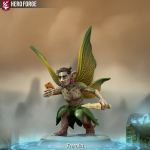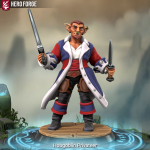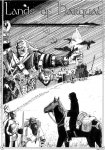Knightfall
World of Kulan DM
DAGHDHA
The Daghdha, The High Druid, The Nature Lord
Greater Deity
Symbol: Celtic shield
Home Plane: Outlands
Godly Realm: Tir na Og (Mag Mell)
Alignment: True neutral
Portfolio: Agriculture, animals, earth, flora and fauna, forests, harvest, nature, weather
Worshipers: Dragons, druids, elves, firbolgs, farmers, gnomes, half-elves, halflings, rangers, anyone who lives in a rural community
Cleric Alignments: LN, NG, N, CN
Domains: Animal, Forest, Plant, Renewal, Weather
Favored Weapon: Spear
The great deity most often referred too as “the Daghdha” is the enigma of the North Gods. The Daghdha, an Old God from the Celtic Pantheon, is an odd sort who is very comical in his demeanor. He neither fits in with the more barbaric members of the pantheon or the ones that gravitate toward order and law. It’s true he is in better company with the chaotic North Gods but even they don’t understand him. His behavior suggests that he would be chaotic in alignment, yet he is true neutral. The Daghdha is a strange bird indeed but Cronn likes him so the High Druid’s place amongst the North Gods is assured.
The Daghdha's Avatar often appears as a tall, lanky human who wears waggish outfits. He’s known for appearing arrayed in multi-colored, frayed garments one minute then in a long, well-kept robe colored in a single primary color. No one ever knows what he’ll look like next, not even his own pantheon members. The one constant is his magical spear, which he calls Little Dragon.
Dogma
The Daghdha teaches respect for the earth and all its wonders. He teaches a balance between the need for agriculture and the natural world. The druids of the Daghdha help farmers with the harvest and teach them how to gather wood for their homes without cutting down tons of trees. They often help communities by predicting dangerous weather patterns and interceding if to many innocents are endangered. They protect nature from those who would abuse it or use it for evil purposes. The tenets of the Nature Lord mesh with the Tenets of the Balance passed down by the clergy of Mirella, for the most part. The Daghdha teaches respect and supplication for The All-Mother and her servants in all cases that endanger the Balance.
Clerics and Temples
The clergy of the Daghdha is made up almost entirely of druids, with a few rangers and shamans as well. The clergy of the Daghdha never accepts evil individuals into the inner circle of the faith, although they are more tolerant towards the masses; who often seek the aid of the Nature Lord. They usually dress in an unorthodox manner to draw attention to themselves and the worship of their god. The Daghdha's clergy tend to keep to themselves, gathering only for important ceremonies and/or festivals.
The Daghdha doesn’t have a strongly organized faith, thus, temples are rarely erected in his honor. More often, the clergy of the High Druid build large, stone circles and monoliths in the Daghdha’s honor. These ‘henges’ are where his clergy gather in the rare times when they do so. More often, one or two high-level druids protect a particular henge from those who would destroy it and watch over those who come to the stone edifice to pray to the High Druid.
The best known location that is a major center for the Daghdha’s faith is the region west of the Kingdom of the Silver Leaves on the edge of the Great Harqual Forest. Known as the Hallowed Lands, the region is a low valley that begins just as the tree line grows thin and the Nameless Hills come into view. The valley cuts through the hills towards the Rilous Mountains and is one of the few locations in that region that wasn’t displaced by the Transformation. The druids believe that the Daghdha saw the danger as it happened and walked the valley from one end to the other, putting a piece of his divinity into the valley so it wasn’t lost to the mists.
The Hallowed Valley is dotted with nearly a dozen henges and is one of the few places where the Nature Lord’s followers gather in greater numbers. These druids make up the largest single circle on all of Harqual. It is said that the entire valley is sacred ground and that the druids can hide the valley from outsiders. Very few have tested this rumor and those that have usually don’t come back.
The High Druid does have one temple-like structure of note. It is a solid wooden building made from deadfalls, moss, and raw stone. The High Druid’s Hall is located between Valeny and Poli in the region known as the Nomad Lands. The structure is hard for non-druids to find, however. As the building magically relocates at dusk every three nights. Only a clergy member of the Daghdha can hope to find the Hall without magical assistance. The bandits of the Lawless Camps give this structure a wide berth, fearing its potent magic and the druid, Kin-Shall (hm / Drd15 (Daghdha) / N), who protects it.
The Daghdha, The High Druid, The Nature Lord
Greater Deity
Symbol: Celtic shield
Home Plane: Outlands
Godly Realm: Tir na Og (Mag Mell)
Alignment: True neutral
Portfolio: Agriculture, animals, earth, flora and fauna, forests, harvest, nature, weather
Worshipers: Dragons, druids, elves, firbolgs, farmers, gnomes, half-elves, halflings, rangers, anyone who lives in a rural community
Cleric Alignments: LN, NG, N, CN
Domains: Animal, Forest, Plant, Renewal, Weather
Favored Weapon: Spear
The great deity most often referred too as “the Daghdha” is the enigma of the North Gods. The Daghdha, an Old God from the Celtic Pantheon, is an odd sort who is very comical in his demeanor. He neither fits in with the more barbaric members of the pantheon or the ones that gravitate toward order and law. It’s true he is in better company with the chaotic North Gods but even they don’t understand him. His behavior suggests that he would be chaotic in alignment, yet he is true neutral. The Daghdha is a strange bird indeed but Cronn likes him so the High Druid’s place amongst the North Gods is assured.
The Daghdha's Avatar often appears as a tall, lanky human who wears waggish outfits. He’s known for appearing arrayed in multi-colored, frayed garments one minute then in a long, well-kept robe colored in a single primary color. No one ever knows what he’ll look like next, not even his own pantheon members. The one constant is his magical spear, which he calls Little Dragon.
Dogma
The Daghdha teaches respect for the earth and all its wonders. He teaches a balance between the need for agriculture and the natural world. The druids of the Daghdha help farmers with the harvest and teach them how to gather wood for their homes without cutting down tons of trees. They often help communities by predicting dangerous weather patterns and interceding if to many innocents are endangered. They protect nature from those who would abuse it or use it for evil purposes. The tenets of the Nature Lord mesh with the Tenets of the Balance passed down by the clergy of Mirella, for the most part. The Daghdha teaches respect and supplication for The All-Mother and her servants in all cases that endanger the Balance.
Clerics and Temples
The clergy of the Daghdha is made up almost entirely of druids, with a few rangers and shamans as well. The clergy of the Daghdha never accepts evil individuals into the inner circle of the faith, although they are more tolerant towards the masses; who often seek the aid of the Nature Lord. They usually dress in an unorthodox manner to draw attention to themselves and the worship of their god. The Daghdha's clergy tend to keep to themselves, gathering only for important ceremonies and/or festivals.
The Daghdha doesn’t have a strongly organized faith, thus, temples are rarely erected in his honor. More often, the clergy of the High Druid build large, stone circles and monoliths in the Daghdha’s honor. These ‘henges’ are where his clergy gather in the rare times when they do so. More often, one or two high-level druids protect a particular henge from those who would destroy it and watch over those who come to the stone edifice to pray to the High Druid.
The best known location that is a major center for the Daghdha’s faith is the region west of the Kingdom of the Silver Leaves on the edge of the Great Harqual Forest. Known as the Hallowed Lands, the region is a low valley that begins just as the tree line grows thin and the Nameless Hills come into view. The valley cuts through the hills towards the Rilous Mountains and is one of the few locations in that region that wasn’t displaced by the Transformation. The druids believe that the Daghdha saw the danger as it happened and walked the valley from one end to the other, putting a piece of his divinity into the valley so it wasn’t lost to the mists.
The Hallowed Valley is dotted with nearly a dozen henges and is one of the few places where the Nature Lord’s followers gather in greater numbers. These druids make up the largest single circle on all of Harqual. It is said that the entire valley is sacred ground and that the druids can hide the valley from outsiders. Very few have tested this rumor and those that have usually don’t come back.
The High Druid does have one temple-like structure of note. It is a solid wooden building made from deadfalls, moss, and raw stone. The High Druid’s Hall is located between Valeny and Poli in the region known as the Nomad Lands. The structure is hard for non-druids to find, however. As the building magically relocates at dusk every three nights. Only a clergy member of the Daghdha can hope to find the Hall without magical assistance. The bandits of the Lawless Camps give this structure a wide berth, fearing its potent magic and the druid, Kin-Shall (hm / Drd15 (Daghdha) / N), who protects it.
Last edited:



